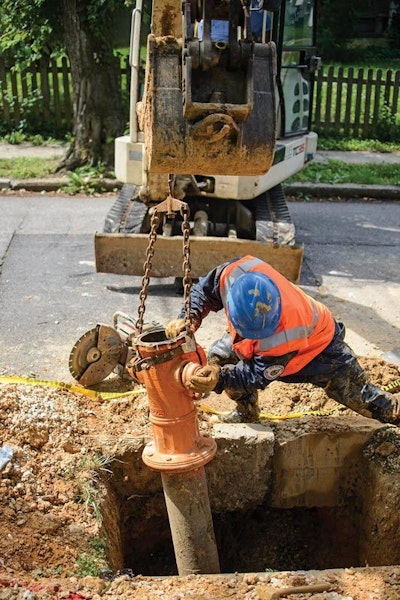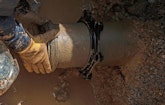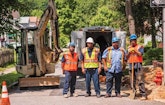Interested in Location/Detection?
Get Location/Detection articles, news and videos right in your inbox! Sign up now.
Location/Detection + Get AlertsAlong one stretch of a key transmission main in the Baltimore Public Works water distribution system, the pipe has ears.
A Pure Technologies Soundprint fiber-optic cable was installed five years ago in a 5.8-mile section of Baltimore’s vital Southwest Transmission Main. The 54-inch pipe delivers water for not only a large part of the city, but to wholesale customers in several neighboring Maryland counties.
Rudolph Chow, the head of the Bureau of Water and Wastewater in the Baltimore Department of Public Works, says the fiber-optic system is used to listen for real-time breaks in the outer wires of the prestressed concrete cylinder pipe.
The Southwest Transmission Main is one of several key conduits in the BPW distribution system that were installed in the mid-1970s and constructed with troublesome Class IV PCCP pipes that have been prone to early failure due to breaks in the prestressed wires embedded in the outer layer of the pipe.
Chow, who joined DPW two years ago, says the bureau installed the acoustic fiber-optic cable in the main as a preventive measure to help protect an aging system that was beginning to experience problems with serious failures in its 1,583-mile network of water mains in the city. In addition to the city, the Bureau of Water and Wastewater also provides wholesale water to five counties in the region — Baltimore, Ann Arundel, Howard, Harford and Carroll — with systems totaling another 2,500 miles of water mains. Overall, the city supplies the water for 1.8 million people.
Chow may be new to the job, but he is not new to the region or to the problems a water system can face if its Class IV PCCP mains begin to fail. Prior to taking the Baltimore job, Chow was at the Washington Suburban Sanitation Commission, which serves many of the suburban communities in the region between Baltimore and Washington, D.C. That system is also being pressed to maintain its Class IV PCCP.
Chow says that when he first joined DPW, his top priority was to assess the condition of the utility’s assets and review the maintenance and replacement programs already in place. As with many systems along the eastern seaboard, one of the key factors in the condition of the Baltimore water mains is age. Nearly 900 miles in the system — more than half of the water mains — are more than 80 years old and water is still flowing through almost 55 miles of mains that were built prior to 1900.
Bigger concerns
Age is not the only concern as DPW employees continue to collect information on the condition of the system. Chow says there are 130 miles of PCCP pipes in the system, with 15 percent of those built with the Class IV steel rings. The steel was the strongest used in the manufacturing of PCCP lines, but the same factors that gave it high tensile strength also made it susceptible to brittleness when exposed to corrosive conditions, and it is therefore prone to breaking.
“These are vulnerable pipes,” Chow says. “Nationally, there are many cities having problems with these Class IV pipes.”
One of the key problems, he says, is that “once they get corroded, they can fail catastrophically without any notice.” The sudden failures are different from many leaks in older, iron water mains which tend to fail slowly as corrosion advances. Those lines develop leaks that often make the problem readily visible long before a major failure occurs.
Compounding Baltimore’s problems is the fact that most of the PCCP pipes are in large diameter transmission lines. A catastrophic failure in one of those lines can cause major damage in the immediate vicinity of the incident while causing water supply headaches over a large part of the utility’s service area.
Gathering data
Because the PCCP was used in major transmission lines, Chow says it is often difficult to get a good idea of the pipes’ conditions. To do a thorough visual inspection would require the city to shut down key sections of the transmission lines, disrupting supplies and stressing other sections of the network. Around the beginning of the 21st century, technology began to emerge that allowed utilities to assess the condition of pipes without disrupting service.
Pure Technologies experts monitor the information coming from the 5.8-mile acoustic fiber-optic line installed in the city’s Southwest Transmission Main and alert DPW employees if they identify a pattern of wires snapping in a section of pipe.
“There are always going to be some breaks in the wire,” Chow says. And a single broken wire is not necessarily a problem. The problem comes when there are a number of breaks in a confined area, a clear sign that the pipe is about to fail. “We can’t rely on how many breaks might already be there, so we have to rely on frequency.
“They will give us notice … they will tell us that in such and such a section there is something going on. When you have a wire break here and there, that’s not alarming. But when you get wire breaking every week, and then maybe daily in one section, then you know you have to get in there and replace or repair one section at a time right now.”
Chow hopes to get funding to install the fiber-optic cable system in all 130 miles of the PCCP in DPW’s water system, even though only 15 percent use Class IV wiring. He says that is the best way to stay ahead of the curve if sections are failing. Cost will be a big hurdle in reaching that goal. The cable itself may be the cheapest part of the system, costing $10,000 to $15,000 per mile installed. The biggest cost is the hardware needed to track the output of the cable. Chow puts that cost at $350,000 per computer and says that one computer station can handle 10 miles of pipe, meaning the city would have to pay for 12 more units to cover the network. Finally, the city pays about $2.50 per foot each year for around-the-clock monitoring by Pure Technologies technicians. The full 130 miles would add up to $1.7 million, Chow says, “So this is not a cheap proposition. We don’t have it currently in our budget.”
New technology
In the meantime, however, the water system has added several new high tech devices to its arsenal of detection tools.
In March 2012, the utility deployed a PipeDiver system from Pure Technologies. “This tool looks like a 12- foot long, worm-like fishing lure,” Chow says. It is inserted on the up-stream end of a main to be inspected and is propelled by fins driven by the water flow. While in use, the tool generates an electromagnetic field that energizes the outer wires of the PCCP mains and takes “snapshots” of each section of pipe.
The information gleaned from the PipeDiver is studied to see if there are any problem spots in danger of imminent failure. The first deployment of the new tool pinpointed severe wire breakage in the Southwestern Transmission Main below some vacant railroad property. The damage was serious enough that BPW officials decided to take immediate action rather than wait until the “off season” in winter when the demand for water is much lower than in the summer months. DPW Director Alfred H. Foxx announced the plans for the shutdown on July 9, 2012, and asked the public to comply with water conservation measures while the main was out of service. The excavation began July 16 and by July 23 the new sections of main were in place and the main was back in service. Chow says that 30 percent of the suspect pipe section had failed wires, calling the situation, “very dangerous on a large, high-pressure main.”
Although the PipeDiver was used on the transmission main that already has the acoustic fiber-optic system, Chow says there is a need for both tools. While the AFO system listens in real time and can pinpoint areas where damage is occurring, it cannot detect where the main may have had damage before it was installed. The AFO serves as an early warning system while the PipeDiver can pinpoint actual damage and weak spots in the main.
BPW has also used the Sahara tethered acoustic inspection system from Pure Technologies to listen to pipes in its network. The Sahara can be used in pipes 6 inches and up and is used to detect leaks or gas pockets in a water service line.
Visual inspections
Whenever repairs force the city to shut down a major water transmission main, Chow says the crews take advantage of the downtime by doing a visual inspection of the portion that is dewatered. “We don’t look at just the 20 feet of main we are replacing. We generally want to physically walk through from valve to valve … that can be several miles sometimes.
“It’s been my experience when you walk two miles or so, you will generally see other sections that need attention and it makes sense to do it while you are already down.”
Even if more problems are found, the emphasis is on expediting repairs. “Most of the time when we go in there we want to get out as quickly as we can.
“We can reroute water, even if we shut down a transmission main, but that can be a problem if you do it very long. If I’m taking down a 72-inch main, I may have to route more water through one that is 45 or maybe 54. For system sustainability purposes, that puts more stress on the smaller transmission mains.”
Other pipes
The focus on the problems with the larger PCCP mains in the Baltimore system doesn’t mean that the water bureau has forgotten about the smaller, iron mains serving most of the communities in the service area. On the same day that work began on the Southwest Transmission Main in July 2012, a 123-year-old 20-inch iron main ruptured in downtown Baltimore, creating a huge sinkhole in a major street and damaging nearby buildings.
Chow says that more traditional inspection methods and careful record keeping will help the bureau track the worst of the problems in its aging system and help the department’s engineers and managers set priorities as he tries to secure better funding to increase the spending for asset management and replacement.
Chow has launched a five-year plan to initiate and gradually ramp up a new asset management plan for the water distribution system. He said the focused program would be a first. “We never had the budget to do water main replacement before now.”
Until recently, the city replaced or rehabilitated an average of five miles of pipe per year. Operating with an assumption that water mains should last for 100 years, Chow said the logical target is to replace 40 miles per year in the overall network his bureau works with, including 15 miles per year inside the city. “Right now, I don’t have the budget for 40 miles per year, so we are starting with 20 miles and next year it would be 25, then 30, 35 and 40.”
The five-year plan to get to 40 miles per year would cost $300 million. “When I get to 40 miles per year, I need to see if we still need to ramp it up more or to hold steady,” Chow says. “That will all depend on the condition of the system and the funding available then.”











